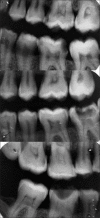Pulp Stones as Risk Predictors for Coronary Artery Disease
- PMID: 32089807
- PMCID: PMC7011460
- DOI: 10.4103/ijpvm.IJPVM_68_19
Pulp Stones as Risk Predictors for Coronary Artery Disease
Abstract
Background: Coronary artery disease (CAD) has been the leading cause of morbidity and mortality worldwide. Studies indicate that patients with CAD show higher degree of pulp calcifications. Localized pulp calcifications are microscopically apparent in more than half of the teeth in young adolescents. However, pulp stones extending to the entire dentition are infrequent and need further evaluation to predict the risk of other probabilities of associated diseases. The present study was planned to estimate the prevalence of pulp stones in patients diagnosed with or, undergoing treatment for CAD.
Methods: The present study consisted of 300 subjects within an age range of 20-55 years who were divided into the study group consisting of 150 patients including 108 males and 42 females as well as 150 age- and sex-matched healthy controls. Pulp stones were imaged using bitewing radiographs using paralleling technique under standard conditions.
Statistical analysis used: The statistical analysis was performed using IBM SPSS statistics 20 Core system software (SPSS Inc., Chicago, IL, USA) while Chi-square test was used to check the prevalence of pulp stones in patients with CAD in addition to their arch-wise and region-wise distribution. P value <0.05 was considered statistically significant.
Results: The present study revealed 100% prevalence of pulp stones in the study group while 90% of the subjects in the control group were also afflicted with pulp stones, though the total number of pulp calcifications observed were lesser in number in the control group compared to the study group (P < 0.05). No significant difference was found, although in the gender predilection for the development of pulp stones in the study group while the control group revealed a definite male predilection with around 96.24% of the males afflicted with pulp stones (P < 0.05). Furthermore, maxillary teeth had a statistically significant predilection for the development of pulp stones in both the study as well as the control groups (P < 0.05).
Conclusions: The patients with CAD have high chance of being affected with pulp stones. Higher prevalence of this entity in multiple teeth may warrant such an individual, in the presence of other compounding risk factors, as a candidate for CAD to be ruled out.
Keywords: Coronary artery disease; pulp stones; risk predictors.
Copyright: © 2020 International Journal of Preventive Medicine.
Conflict of interest statement
There are no conflicts of interest.
Figures
References
-
- Kasper DL, Harrison TR. Harrison's Principles of Internal Medicine. 15th ed. New York: McGraw.Hill; 2005.
-
- Sadr Bafqi SM, Salari M, Rafiee M, Nemayandeh SM, Abdoli AM, Karimi M, et al. Prevalence and criteria of metabolic syndrome in an urban population: Yazd healthy heart project. Tehran Univ Med J. 2006;64:90–6.
-
- Orban BJ, Sicher H, Bhaskar SN. Orban's Oral Histology and Embryology. 12th ed. Saint Louis: Mosby; 1972.
LinkOut - more resources
Full Text Sources
Miscellaneous

